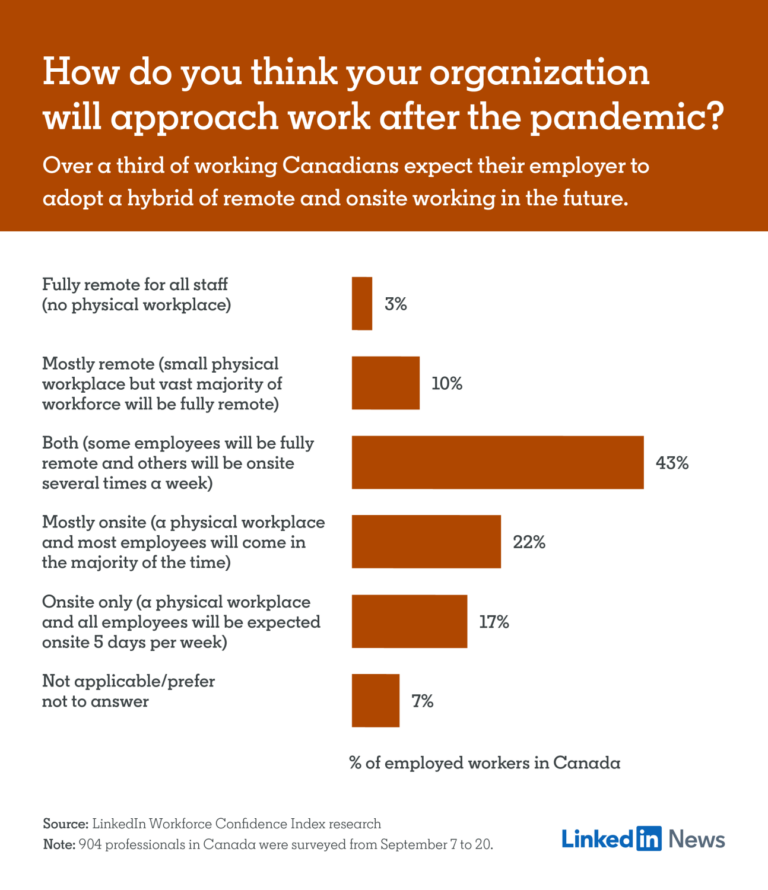For many companies, the transition from in-office to remote or flexible work at the beginning of the pandemic may have started off a bit rocky. However, a recent survey from LinkedIn shows that, among Canada’s newly remote workforce, the original concerns around a lack of productivity or focus appear to have diminished. As this global work-from-home experiment is becoming routine, only 19% of respondents are currently concerned about achieving less at their jobs while remote.
On the other hand, around 36% of respondents continue to struggle to balance their personal and professional lives while working remotely, 32% work longer hours than before, and 27% face challenges communicating with colleagues and customers.
The same survey also shows that remote teams are expected to stick around in the post-COVID new normal, at least for those who want it. In fact, only 17% expect all staff to be onsite five days a week!
 At Impetus Digital, we have 12 years of experience working with and managing a 100% remote team. In fact, I have previously explored this topic as part of our Courageous Conversations series, available on YouTube and as a podcast. Based on that, here are my top 10 tips for creating company culture in this virtual world that we live in.
At Impetus Digital, we have 12 years of experience working with and managing a 100% remote team. In fact, I have previously explored this topic as part of our Courageous Conversations series, available on YouTube and as a podcast. Based on that, here are my top 10 tips for creating company culture in this virtual world that we live in.
1. Adopt a growth mindset
If COVID-19 has taught us anything, it’s that company leaders need to expand themselves and look at the silver linings; what first seemed like an obstacle might actually be an opportunity to grow and create something even better than what you currently have. The last year has been a very stressful time for company leaders and employees alike, and taking time for self-reflection and internal growth will help you become a better leader to your virtual team.
2. Create new norms, processes, values, and expectations for your remote team
Just like moving to a new house or city, team members need time to familiarize themselves with the new reality of working remotely. Let everyone explore what does and does not work for them. Work together and incorporate their feedback to establish clear and realistic processes and expectations.
3. Determine the team’s new “why” in the virtual world
This encompasses developing clear workflows and easily accessible documentation. If team leaders backtrack and spend some upfront time on developing this framework and foundation for how the team will work together in the new virtual environment, it will pay off greatly in the long-run.
4. Leverage the right tools to recreate the “onsite” work experience for your remote team
There is a myriad of free and paid online tools designed specifically for remote teams. It is worth taking the time to research these and deciding which ones will best fit into your specific company. Consider how these can be integrated into your workflow and make sure that they are user-friendly while still containing all required features to help you get work done in a timely and efficient manner. This should include both synchronous tools for one-on-one and group meetings, as well as asynchronous tools, and there need to be clear guidelines for which situations to use each different tool.
5. Optimize the type, number, and length of your team meetings
The pandemic has confirmed the notion that, while some team meetings can be great for idea-generation and brainstorming, many others could (and should) have been an email.
The transition to remote working has sparked an explosion of memes. Source: Google Images, makeameme.org, and memegenerator.net; creators unknown.
Jokes and memes aside, web meetings can be draining, especially if long or if you are attending several each day. At Impetus, we typically counsel our clients to keep their synchronous virtual meetings short and, if needed, supplement them with pre- or post-meeting asynchronous touchpoints so that less time can be spent on didactic presentations. We follow the same approach with our internal team as well, focusing mainly on asynchronous communication while strategically adding synchronous web meetings. This allows us to maximize and optimize the time spent in web meetings and lets us focus on decision-making rather than back-and-forth debates or data dumps.
6. Define your teams and determine who needs to attend each meeting
Related to point #5 above, company leaders should try to design the virtual office space so that people know and understand their roles and know where to go to find and do things or to speak to different people. Ultimately, you also want people to know who is responsible and accountable for what. This might mean that only some people attend a meeting while others get updated asynchronously, as part of another meeting later on, or by watching a meeting recording. Be conscious of others’ time and commitments and only invite them to meetings when it makes sense. If looking for new solutions or ideas from another perspective, use asynchronous communication tools to open up your meetings to diverse opinions from other remote team members.
7. Learn the difference between outcome control vs. process control
As shown in the stats above, while there was originally a lot of concern that there would be a lack of productivity with remote work, this concern has greatly diminished now that companies have gained hands-on experience.
As a leader, you have to become comfortable with outcome control vs. process control. The divide between work life and home life has been erased in 2020. Many people are now sharing a home office with a partner or are home-schooling their children while trying to work. Being able to shift focus from the process to the outcomes and trust your employees to get the work done, no matter how they do it, will help empower them and make this transition easier for everyone involved.
8. Share vulnerability
People need to feel psychologically “safe” in the virtual office. As a leader, you can set the scene and allow for vulnerability by being real and genuine. Check in with your team asynchronously. What were their wins yesterday? What are the barriers they’re facing today? Set time aside for synchronous one-on-one check-ins where you allow both yourself and your colleague to be vulnerable and openly discuss what is and what is not working for them in this new setting.
9. Use webcams (even when having a bad hair day or home-schooling the kids)
A lot of people are still uncomfortable being in front of webcams, especially if at home in their pajamas, with imperfect hair or no make-up. The key here is to inspire and change the culture and acknowledge the fact that we are no longer at a physical office and that the same dress code does not apply. We need to not just allow, but embrace, that vulnerability and acknowledge that everyone’s situation is different. While uncomfortable, webcams help us see the body language and facial expressions that are otherwise lost. Are people feeling sad, happy, uncomfortable, nervous, bored? Sometimes, people may be joined by their pet or toddler (as in the infamous BBC News video below), and remote team members need to know that you empathize and support them so that they feel safe in these situations.
The reality of working from home for many young parents during lockdowns and quarantine.
10. Have fun with your employees!
Finally, use webcams to do fun things like adding themed backgrounds, have weekly team coffee breaks or happy hours, play online trivia or board games, organize fun team competitions. Basically, anything you would have done for fun in the office, do it virtually. Why not send the team a questionnaire to get their suggestions?
Moral of the story: keeping employees involved, informed, happy, and fulfilled will pay off a hundredfold in the long-term.
About Impetus Digital
Impetus Digital is the spark behind sustained healthcare stakeholder communication, collaboration, education, and insight synthesis. Our best-in-class technology and professional services ensure that life science organizations around the world can easily and cost-effectively grow and prosper—from brand or idea discovery to development, commercialization, execution, and beyond—in collaboration with colleagues, customers, healthcare providers, payers, and patients.




